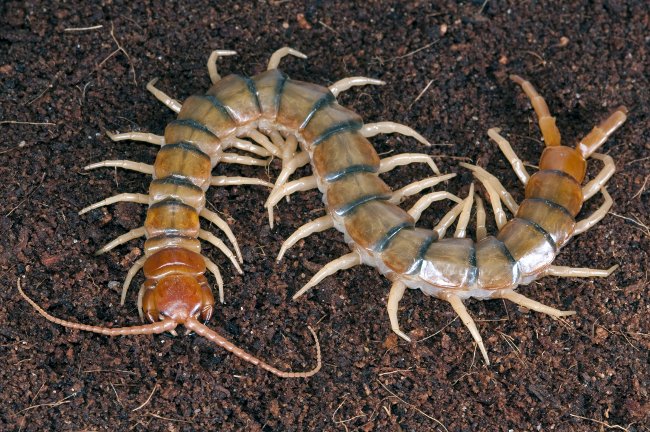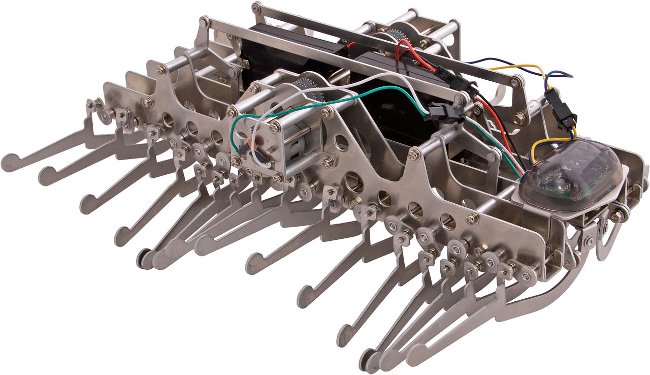Multi-legged robot inspired by centipede
The device simulates suspicious advantages when moving creatures.
What makes centipedes able to move so fast? Researchers at Kyoto University have simulated and used machines to find answers - and the surprising truth.

Centipedes are arthropods, elongated and capable of moving very quickly. The number of legs on both sides of them is very much but they can still work smoothly between the legs to move quickly and extremely stable.
Perhaps, we still do not understand why the centipedes move so skillfully, they even overcome difficult obstacles easily. Researchers at Kyoto University have found the correct answer to this question and they simulated them on computer models and used the necessary machines to prove it.
What they offer helps us have a clear view of the motility of the centipede, which is called the instability of domestication - a factor that is considered unfavorable - a key factor with success. of centipedes.
Leading scientist Shinya Aoi explained that: " During their movement, many feet exposed to the ground help the body resist the attraction and produce thrust and braking force. Many legs also help the body restricts touch to the ground and this restriction can hinder their ability to move. "

The centipede overcomes these obstacles by using instability, exploiting the movement characteristics in their undulating terrain.
Scientist Aoi went on to say: "Our team has developed a mathematical model of centipedes and found that straight paths are easy to move and body movements appear gradually through a superficial branch. Hopf by changing the motor speed and flexibility of the body axis , "is more explicit than the mathematical description of the system's inclination from stable to unstable.
First, with computer models and then multi-legged and multi-segment robots, the team was able to copy the movement of the centipede, including the wave-shaped body motion described in an article in Scientific Reports Scientific Online.
But scientist Aoi and his colleagues are not satisfied with simple domesticated crawling movements.
He said: " This study provides evidence of unexplained problems in the intelligent control functions of animals and has an insight and significance for the biological sciences ," to There are still many unknowns in animal transport mechanisms.
And to better understand, this research can help robots move better - no matter how many legs they have.
Below is a video describing the movement of centipedes, please see to understand more about them.
You should read it
- Trace 'dick' to grab the chance to attack the snake which is laying eggs
- Small autonomous robots can think and act like insects
- 10 robots have succeeded in proving they are new generation animals
- New firefighting robots are put into testing
- The world's most complicated maid robot dog will be released later this year
- Russian new robots can shoot themselves with two hands like humans
- Turtle robots help archaeologists study shipwrecks underwater
- Sophia - What is the world's first civilian robot in Saudi Arabia?
May be interested
- Robot milliDelta robot is set up with roles in production and medicine
 a millidelta robot developed at harvard university promises to open the era for applications in manufacturing and medicine thanks to its innovative creations.
a millidelta robot developed at harvard university promises to open the era for applications in manufacturing and medicine thanks to its innovative creations. - Primer - Super transform robot like Transformer
 the special robot is called primer, made from a stretched polymer plastic. it can change shape when increasing temperature and controlled by magnet.
the special robot is called primer, made from a stretched polymer plastic. it can change shape when increasing temperature and controlled by magnet. - Why are there no three-legged creatures on Earth?
 there are things that never exist on earth, one of which is a three-legged creature.
there are things that never exist on earth, one of which is a three-legged creature. - Giant Robot War: America wins Japan
 i wonder what would the real giant robots fight in real life?
i wonder what would the real giant robots fight in real life? - The world's first terrain-crossing robot can move like a snake
 recently, a research team in israel has successfully developed the first robot in the world that can create a wave-shaped motion with just one motor. this new robot is developed based on snake movement.
recently, a research team in israel has successfully developed the first robot in the world that can create a wave-shaped motion with just one motor. this new robot is developed based on snake movement. - 10 robots have succeeded in proving they are new generation animals
 by observing the natural world, scientists have designed many robots based on the world and the environment of animals. this shows that the intersection of science and nature is an essential part of life. moreover, these robots are also calculated to be compatible with future needs.
by observing the natural world, scientists have designed many robots based on the world and the environment of animals. this shows that the intersection of science and nature is an essential part of life. moreover, these robots are also calculated to be compatible with future needs. - Korea stirs because robot employee 'self-destructs'
 on june 26, gumi city council (south korea) announced that the administrative staff robot manufactured by bear robotics fell down a 2m high staircase last week and no longer responded.
on june 26, gumi city council (south korea) announced that the administrative staff robot manufactured by bear robotics fell down a 2m high staircase last week and no longer responded. - The robot already knows how to dribble, pass people, and score goals
 scientists at google deepmind trained the robotis op3 robot to play soccer using an ai training technique called deep reinforcement learning.
scientists at google deepmind trained the robotis op3 robot to play soccer using an ai training technique called deep reinforcement learning. - Russian new robots can shoot themselves with two hands like humans
 fedor, the famous russian-style robot has been successfully equipped with a special skill ... shooting itself without any robots in the world, to contribute to the mission to set foot on the moon in the year. 2021.
fedor, the famous russian-style robot has been successfully equipped with a special skill ... shooting itself without any robots in the world, to contribute to the mission to set foot on the moon in the year. 2021. - Xiaomi launched the vacuum cleaner robot Mi Robot 1S capable of memorizing maps, scanning each room according to the installation schedule
 xiaomi has just launched mi robot 1s, the upgraded version of the robot vacuum cleaner model is quite popular and is being sold genuine in vietnam.
xiaomi has just launched mi robot 1s, the upgraded version of the robot vacuum cleaner model is quite popular and is being sold genuine in vietnam.










 The magic vase kept 'drinking up'!
The magic vase kept 'drinking up'! Create sponge that can boil water
Create sponge that can boil water Vietnam invented the world's first worm rescue machine
Vietnam invented the world's first worm rescue machine Get a fever with new fabrics that generate electricity in the future
Get a fever with new fabrics that generate electricity in the future